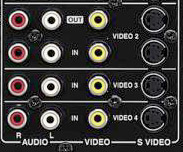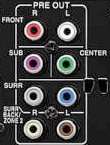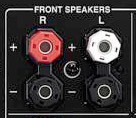|
||||||||||||||||||||
|
Surround sound lets the movie makers "recreate" the sound of the spaces and events they are portraying on screen. By putting into the surround speakers the sound of chirping birds, wind whistling through trees, or a helicopter just about to appear on screen, the atmosphere is more realistic and believable, immersing us further into the movie. In addition, having several separate channels of sound behind the screen lets the movie maker provide a much more convincing sonic image up front since the sound of a car whizzing across the screen can move with the image of that car. Back then, multiple channels of sound were only possible by putting magnetic sound tracks (like there are on magnetic recording tape) to the side of the picture frame on the big 70mm film prints. Because these prints were expensive, economies of scale drove them out of the mainstream by the late 60s. Surround sound was only available on the biggest budget films and even then, only in big "first run" 70mm capable theaters in major cities. In 1977, Star Wars brought us not only a new genre of science fiction film, but a new sound format that would impact motion pictures like no other. Dolby created a way to deliver four channel soundtracks optically on ubiquitous 35mm film. Through their experience with noise reduction technology, Dolby was able to put two optical audio channels on the film in the space previously occupied by the Academy Optical Mono track. They embedded a center and surround channel into these left and right optical tracks. This is called a Matrix. When decoded in the theater, the system yielded three screen channels and one surround. The thrill of multiple screen channels and surround sound was now available for all movies at reasonable production costs. By the mid 80s, virtually every commercial movie release featured four-channel Dolby Stereo sound. In 1992, with the release of
Batman Returns, Dolby unveiled the next generation of motion
picture sound, Dolby Digital (a.k.a. Dolby Stereo SR-D). Dolby Digital (DD) features three front screen channels, two
surround channels, and one LFE (Low Frequency Effect) track. The sound is
stored on the film in digital form, and all channels are discrete, meaning that each channel is a
distinct or separate track in the recording, rather than the rear channel
and front center channel having to be extracted from two stereo channels
like it is with Dolby Stereo. Today, just about every commercial
movie release features a Dolby Digital Soundtrack. As home video took hold, it was realized that when a movie was transferred to Laserdisc or Hi-Fi (Stereo) VHS, the original two-track Dolby Stereo soundtrack had come along for the ride. All that remained to realize surround sound at home was a processor, much like the one in movie theaters, which would take that stereo sound and decode it into surround sound. Home Theater effectively was born! At first, surround sound at home consisted of expensive, yet rudimentary surround sound decoders. It did not take long before the surround sound decoding made its way into receivers, as well as more upscale audio preamplifiers. Integrated receivers with surround sound processing and power amplifiers to drive the speakers have come to be known as A/V Receivers, or Surround Sound Receivers, while the preamplifiers with surround sound decoding (but no power amplifiers in the chassis) have come to be known as Surround Sound Processors, or Surround Sound Preamps. Both have evolved into being the central hub of the home theater system. In addition to being able to process and route the audio, receivers also now can process and route the video signal. Many new receivers have second and third zones, letting you watch movies in several rooms, using the receiver as the hub. So Many Formats to Choose From Let's talk about the various surround sound formats which you will find on today's A/V Receivers and Surround Sound Processors.
Dolby Pro Logic, like Dolby Stereo in the movie theater, converts two tracks of sound into four channels. In the days of Laserdisc and Stereo VHS it literally was the only thing going. While dated and overshadowed by newer technology, Dolby Pro Logic remains vital: It is used whenever the medium is limited to two channel and may even be used when technology permits more, in order to save space or preserve the artistry of an original audio work.
Dolby Digital
While two channel CD Audio has about a 1.5 mbps bitstream, Dolby Digital uses as little
as 384 kbps in total for all six channels. Obviously, this requires considerable
compression of the audio data (about 10:1). Dolby utilizes "Perceptual
Encoding" for this process, putting only those sounds that the brain would
pay attention to in the sound tracks. This necessitates very sophisticated
algorithms (a series of mathematical formulas) to determine what to include
and what to eliminate. In practice, the sound quality is spectacular.
While initially a very expensive system for consumers, every surround sound
decoder on the market now has Dolby Digital as part of the feature set. There are some who feel that the DTS codec results in better sound because it uses less compression, but because the two codecs are different, the bitrates cannot be compared at face value (i.e., it could simply be that DTS is less efficient than AC-3 as opposed to actually sounding better). We at Secrets have never been able to definitively show that DTS sounds any better than Dolby Digital. Whereas DTS used to come at a premium price, it is now found on virtually every surround sound decoder on the market.
Dolby Pro Logic II is a much improved decoding system for Dolby Stereo encoded material and also caters to the decoding of non-encoded material such as regular two channel music. It differs from it predecessor by achieving a more intelligent extraction of the channels, so much so that instead of a single surround signal, Dolby Pro Logic II yields stereo left and right surrounds. For compatibility with movies and other Dolby Stereo encoded material, Pro Logic II has a Movie mode. Because non-encoded material such a music more often than not collapses to center (all the sound seems to come just from the center speaker), Pro Logic II also has a Music mode which works extremely well and can include user access to parameters to customize the sound field.
Dolby Digital Surround EX first appeared in movie theaters with Star Wars Episode I: The Phantom Menace. This system starts from a standard Dolby Digital 5.1 soundtrack but then applies a form of Pro Logic decoding to the two rear channels only, and derives a third surround channel, positioned between the other two. So from a 5.1 soundtrack, Dolby Digital Surround EX derives a 6.1 soundtrack. This new system first became available to the home market on THX equipment as THX Surround EX because THX co-created the new system. It is now available on non-THX decoders as Dolby Digital EX. Ideally, a soundtrack needs to have been crafted for this system in order for it to sound right. The surround sound information of non-EX encoded tracks can come out predominantly from the center surround channel and lose spaciousness.
DTS also delivered some 6.1 systems. The first, DTS ES, is in all practicality the same process as Dolby Digital EX in that the playback system applies a matrix decoder to the two surround channels to derive a third between them. DTS ES Discrete on the other hand actually added a sixth discrete main channel. Whereas there are precious few Dolby Surround EX soundtracks on DVD, there are even fewer DTS ES and fewer still DTS ES Discrete. That sixth channel has just not been very successful.
Dolby Pro Logic IIx takes virtually any source track, be it two channel or 5.1, and yields up to seven channels of sound by employing the latest in matrix decoding technology. Integrated or Separates You might be surprised to learn that the integrated package, the A/V Receiver or Surround Sound Receiver, with everything is the less expensive. The reason for this is that integrated systems are manufactured in very large numbers and mass marketed. The other units, the Surround Sound Processors or Preamps, are made in far fewer numbers, and the electronic quality is usually, but not always, higher. So, you have an important choice to make. An integrated package with power amplifiers for all of the channels can be purchased for about $250 - $6,500, with most people spending between $600 and $1500. A preamplifier/surround processor, with separate power amplifiers can run $2,500 - $25,000. Although never a hard and fast rule, the dedicated surround processors are expected to have higher quality analog electronics. Decoding chips that can decode DD and DTS in one
chip became available in mid-1998, and receivers with decoding of all
formats built-in are commonly available now at very low prices. What you pay
for in the more expensive receivers are more ancillary features and higher power in
the amplifiers. There is no substitute for raw power in home theater sound. Whether receiver or separates, as a general rule, we feel that at least 100 watts are needed for each channel. This is in watts continuous or RMS, not peak power watts, and at 8 ohms speaker impedance. Many integrated packages (surround sound receivers) offer this much power, and we suggest getting as much power as you can afford. Even though you will only be using about 15 - 50 watts per channel at any one time, having the capability of high power output will result in these 15 - 50 watts being on the "linear" portion of the distortion curve, which means it will sound much better than if the amplifier had a capability of only 50 watts per channel, and you were running the amplifier at full output all the time. Also, you will be surprised at how much impact a loud special effect can have when 100 - 200 watts are available to drive it.
Connectors and Other Features The inputs may not all be labeled exactly the same way on every receiver, so you should ask the salesperson about the number of inputs, and ability to connect the above mentioned sources. Capability of dubbing from one audio cassette deck to another, and one VCR to another should be present (you won't be able to copy DVD movies to your VCR since copy protection in the DVD prevents this). If you are looking at a separate processor, it will have 5, 6, 7, or even 8 line-level audio outputs for connecting to power amplifiers: front left, center, front right, left/right surround (plus left/right rear or center surround for the various Surround EX stuff), and at least one subwoofer out. As we've mentioned, even with A/V Receivers it is nice to have a complete set of pre-out jacks should you decide to upgrade to higher quality power amplifiers later. It is a feature to look for. If you
want to have Dolby Digital with older laserdiscs, then the receiver or
processor should have an AC-3 RF input jack. This
takes the RF signal from the laserdisc player, containing the DD signal, and
demodulates it in preparation for decoding. DVD players may have a Toslink optical digital output jack, and/or a coaxial
digital output jack. Receivers these days tend to have both types of digital
input jacks, but you should make sure that the digital output on your DVD
player matches the input on your receiver.
Surround Sound Alternatives While all this can
"get you by", ultimately there is no substitute for full surround sound!
If for example you choose not to use a center speaker and you are seated even
slightly off center, dialogue during the movie will appear to come from the
speaker closest to you, and not from the video image as it should. Specific to
surround sound decoders are the THX "Post Processes": Re-Equalization
applies a specific roll-off of high frequency information to address the
fact that home theaters reflect and sustain high frequency energy much more
than a properly configured mix facility or movie theater. Without Re-EQ, we are compelled to turn down the volume in response to
the uncomfortable treble, thereby missing the more subtle elements of the
soundtrack. THX Ultra2 Cinema/Music/Game is THX's own effort at a surround sound decoding scheme which can take a 5.1 soundtrack and turn it into 7.1 (found only on THX Ultra2 products and not on the original Ultra or Select product). At one time, THX products came with a tremendous premium in their price, but that is clearly no longer the case. THX Select A/V Receivers are available for well under $1,000 and virtually all good Surround Sound Preamps are THX Ultra or Ultra2 certified. With this in mind, and the fact that being THX certified cannot possibly hurt, a THX-certified A/V Receiver or Processor should be on your short list when shopping.
|
||||||||||||||||||||

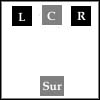 Dolby Pro Logic
Dolby Pro Logic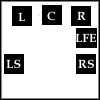 Dolby Digital (also known as the AC-3 Codec) was first made available to consumers on
special Laserdiscs. It came into the mainstream when it was chosen as
the multi-channel codec for the DVD Video format. It is an extremely flexible
codec which can carry from 1 to 6 completely separate and independent channels of
digital sound.
The full six-channel configuration consists of the
front left, center, front right, rear left and right, and the LFE channel
(or Low Frequency Effects channel). The LFE channel
has a restricted frequency range, while all the other channels are full
range (8 Hz - 20 kHz), so the system is often called "5.1".
Dolby Digital (also known as the AC-3 Codec) was first made available to consumers on
special Laserdiscs. It came into the mainstream when it was chosen as
the multi-channel codec for the DVD Video format. It is an extremely flexible
codec which can carry from 1 to 6 completely separate and independent channels of
digital sound.
The full six-channel configuration consists of the
front left, center, front right, rear left and right, and the LFE channel
(or Low Frequency Effects channel). The LFE channel
has a restricted frequency range, while all the other channels are full
range (8 Hz - 20 kHz), so the system is often called "5.1".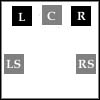 Dolby Pro Logic
II
Dolby Pro Logic
II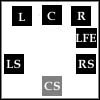 Surround EX
Surround EX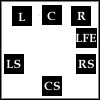 DTS ES and ES
Discrete
DTS ES and ES
Discrete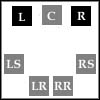 Dolby
Pro Logic IIx
Dolby
Pro Logic IIx
